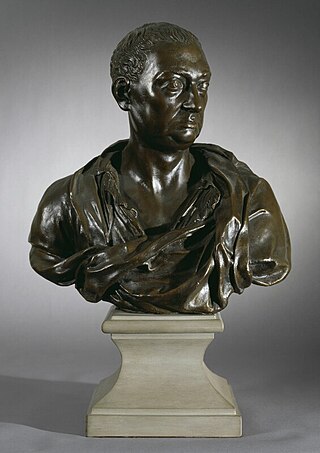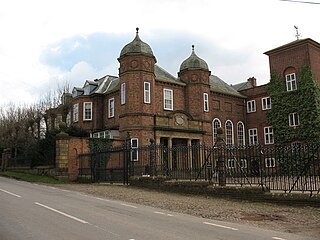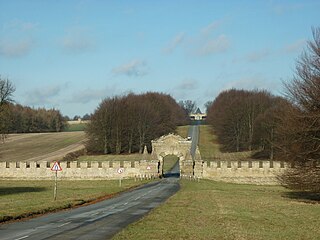
Nicholas Hawksmoor was an English architect. He was a leading figure of the English Baroque style of architecture in the late-seventeenth and early-eighteenth centuries. Hawksmoor worked alongside the principal architects of the time, Christopher Wren and John Vanbrugh, and contributed to the design of some of the most notable buildings of the period, including St Paul's Cathedral, Wren's City of London churches, Greenwich Hospital, Blenheim Palace and Castle Howard. Part of his work has been correctly attributed to him only relatively recently, and his influence has reached several poets and authors of the twentieth century.

Castle Howard is an English country house in Henderskelfe, North Yorkshire, 15 miles (24 km) north of York. A private residence, it has been the home of the Carlisle branch of the Howard family for more than 300 years. Castle Howard has been used as a filming location in several films and television shows, including in Granada Television's 1981 television adaptation of Evelyn Waugh's Brideshead Revisited and in a 2008 film adaptation.

Christ Church Spitalfields is an Anglican church built between 1714 and 1729 to a design by Nicholas Hawksmoor. On Commercial Street in the East End and in today's Central London it is in the London Borough of Tower Hamlets, on its western border facing the City of London, it was one of the first of the so-called "Commissioners' Churches" built for the Commission for Building Fifty New Churches, which had been established by an act of parliament in 1711.

St Luke's is a historic Anglican church building in central London, and in the London Borough of Islington. It served as a parish church from 1733 to 1959. It was designed by John James and Nicholas Hawksmoor, and is a Grade I listed building.

Duncombe Park is the seat of the Duncombe family who previously held the title Earls of Feversham. The title became extinct on the death of the 3rd Earl in 1963, since when the family have continued to hold the title Baron Feversham. The park is situated one mile south-west of Helmsley, North Yorkshire, England and stands in 300 acres (120 ha) of parkland. The estate has a commanding location above deeply incised meanders of the River Rye within the North York Moors National Park.

Ribston Hall is a privately owned 17th-century country mansion situated on the banks of the River Nidd, at Great Ribston, near Knaresborough, North Yorkshire, England. It is a Grade II* listed building.
William Etty was an English architect and craftsman, best known for designing Holy Trinity Church, Leeds and (probably) Holy Trinity Church, Sunderland.

The Temple of the Four Winds is a historic building in the grounds of Castle Howard, in North Yorkshire, in England.

Henderskelfe Castle, or Henderskelf Castle in older texts, was a Medieval castle in Henderskelfe, North Yorkshire. It stood on what is now the site of Castle Howard, a large stately home.

Henderskelfe is a civil parish in North Yorkshire, England. The parish does not contain any villages, though it is named after a previous settlement and castle which occupied the land on which Castle Howard is now built. Historically the area was a township in the ecclesiastical parish of Bulmer, however it has been its own civil parish since 1866.

Helperby Hall is a historic building in Brafferton and Helperby, a village in North Yorkshire, in England.

The Carrmire Gate is a folly forming part of the estate landscape of Castle Howard, a country house in North Yorkshire, in England.

Dishforth Village Hall is a historic building in Dishforth, a village in North Yorkshire, in England.
Henderskelfe is a civil parish in the former Ryedale district of North Yorkshire, England. It contains 62 listed buildings that are recorded in the National Heritage List for England. Of these, 16 are listed at Grade I, the highest of the three grades, 16 are at Grade II*, the middle grade, and the others are at Grade II, the lowest grade. The parish does not contain any settlements, and its most important building is the country house, Castle Howard. This is listed, and all the other listed buildings in the parish are associated with the house, in its surroundings, gardens, grounds and estate.

The Walled Garden is a historic garden at Castle Howard, in North Yorkshire, in England. It contains several notable structures.

The Pyramid Gate, also known as the Pyramid Gatehouse, is a historic building at Castle Howard, in North Yorkshire, in England.

Ray Wood is a woodland area of the Castle Howard estate in North Yorkshire, in England. It contains several historic structures.

The Pyramid is a folly on the Castle Howard estate, in North Yorkshire, in England.

The Stables are a historic building at Castle Howard, in North Yorkshire, in England.

Pretty Wood is a woodland area of the Castle Howard estate in North Yorkshire, in England. It contains two historic structures.


















